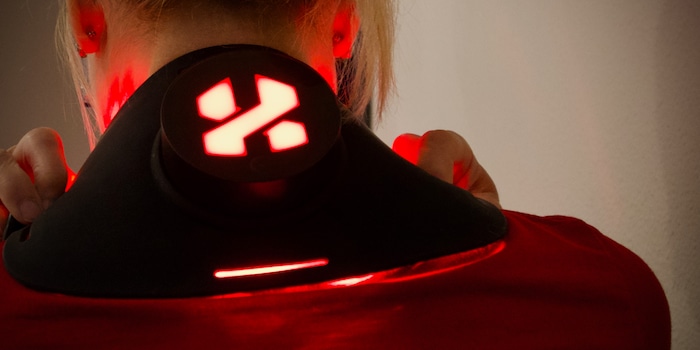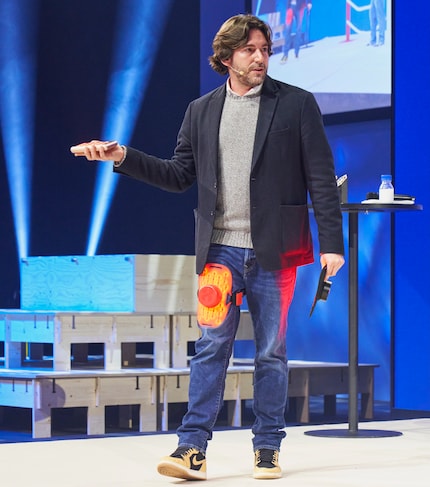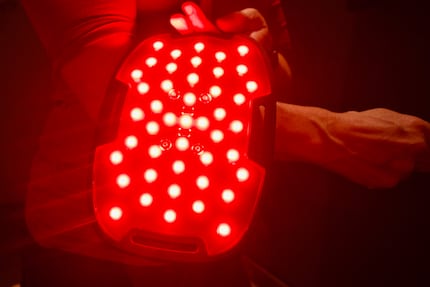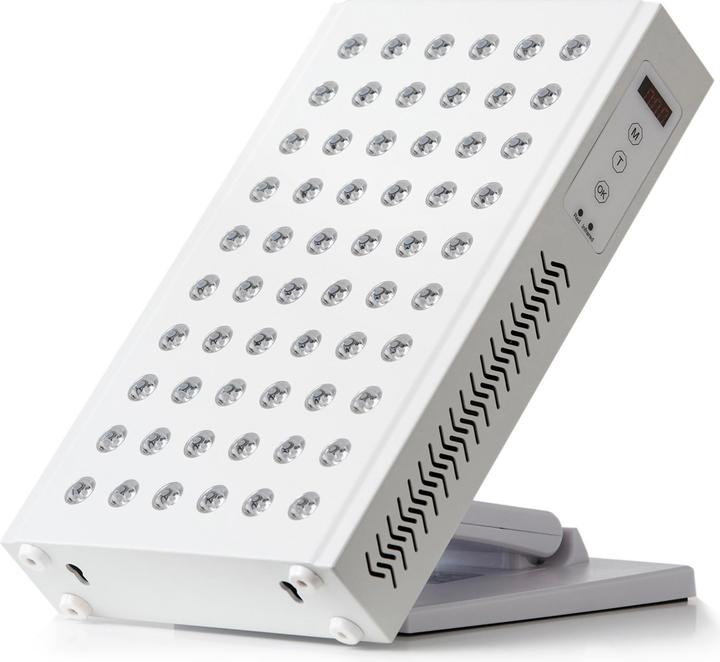

Red light therapy for muscle recovery – is there anything to it?
Anyone interested in athlete regeneration will sooner or later stumble across the term «near-infrared light». Recently, a small, waterproof red-light-therapy device was presented at ISPO. But is there anything to it?
One evening, I was sat in my hotel room pressing an oval silicone doodad with 45 red LED lights against the back of my neck for ten minutes. Then I repeated the procedure on my elbow. And, finally, I wrapped the device around myself so that the red LED lights illuminated my lower back. I had spent the whole day running my feet flat at the ISPO international sports fair. My muscles were tired and I felt a slight pull in my back. Presented with the chance to try out a device meant to promote recovery, I jumped at it.
My curiosity is piqued
Body Pro – that’s the name of the device made by Lumaflex that was entered into an ISPO innovation competition. While it didn’t win an award this time around, the Body Pro won TIME’s award for Best Inventions of 2023 in the wellness category. That’s reason enough for me to take a second look at the underlying technology.

Source: ISPO
Disclaimer: I’m always sceptical about devices for home use that promise health-promoting effects through light, vibration or other types of oscillation. The Lumaflex Body Pro was no exception. But as I had recently stumbled across articles like this one in the Wall Street Journal and scientific studies on the subject of photobiomodulation (what a mouthful!), my curiosity was piqued. YouTube channels are also increasingly addressing the use of visible and invisible red light. Is there anything to this trend? I wanted to delve deeper into the subject matter.
Interested in light therapy? Join me on my journey to find out more. Mind you, this isn’t a detailed review of the Lumaflex Body Pro. I only had it with me for one night to form a first impression. But it’s a positive one; it seems solidly built and is easy to operate.
How does red light work?
Light therapy has been around since the 1960s, when the Hungarian doctor Endre Mester experimented with lasers and discovered that a certain wavelength of light stimulated wound healing and hair growth in rats. Studies by NASA followed in the 1990s, which showed that, in space, red LED lamps improved photosynthesis in plants and, on Earth, red LED lamps improved the healing of astronauts’ wounds. At the time, the mechanism of action wasn’t yet known. And – as so often in science – other studies produced contradictory results. This led the research to peter out. Red light therapies were banished to the esoterism corner and soon discounted as mumbo jumbo. Partly to blame for this were the exaggerated healing promises made by a US manufacturer, which ended with the responsible party and two distributors being convicted of fraud.
The mistrust started slowly fading away once scientists began to demonstrate red light’s mechanism of action in cells. Long-wave red light has a positive effect, especially on mitochondria (the powerhouses of the cell) that no longer function optimally due to illness or ageing.
By now, there are thousands of studies on the effects of near-infrared light, though some of them still show contradictory results. What makes it particularly confusing is the fact that red light therapy underwent a name change – from Low-Level Laser Therapy to Low-Level Light Therapy to photobiomodulation – once it was discovered that not only lasers but also LEDs produced the desired effects. Today, the term photobiomodulation is used when speaking of the effects of long-wave red and near-infrared light. Another important thing to note is that certain studies use light of different wavelengths and different strengths. Why? Because different wavelengths can penetrate tissue to different depths.
What are the benefits of near-infrared light after sport?
In order to (quite literally) shed some light on the subject, I turned to Dr. Alexander Wunsch, who has been studying this topic for more than 30 years. I came across him through an article in the sports medicine journal Sportärztezeitung. «The body has developed mechanisms for filtering out potentially harmful light, that is, very short-wave and long-wave light, as far as possible at the surface. Only harmless or beneficial light can penetrate up to several centimetres deep into tissue,» he explains. This kind of light covers wavelengths from 600 to 1,400 nanometres – a cold-red light at the edge and beyond the visible spectrum, which differs from warm-red light in wavelength and effects. In other words, the devices used in photobiomodulation are very different from red radiant heaters, for example, which are supposed to help with sinusitis, or from infrared saunas.

Source: Siri Schubert
In sport, for example, the near-infrared light can help make the muscle contract for longer (by providing more ATP), explains the physician. As a result, the muscles don’t tire as quickly. An anti-inflammatory effect in the joints and muscles has also been demonstrated in and established through studies. Near-infrared light is also reported to improve recovery after strenuous exercise and the resulting minor muscle damage.
From theory to practice
Of course, the leap from scientific studies to a device that I can buy for home use is a big one. «In general, you can’t go too wrong with a wavelength of 630 to 850 nanometres,» says Alexander Wunsch.
He gives me another tip: «If there’s no illness or damage to the muscle and tissue, the effects of photobiomodulation aren’t very noticeable.» In other words, fit, healthy, sporty people will probably notice fewer effects of near-infrared light than, say, athletes with injuries or severe signs of fatigue after a competition.
My verdict: I’ll be keeping an eye on near-infrared light
A lot has happened in recent years in photobiomodulation research. There’s clearly potential for its use to support the healing of sports injuries and perhaps also to improve performance. After using the device briefly at the hotel, I can’t say much except that I’ll certainly give near-infrared light a go the next time I have a sports injury. I’m curious to see what effect it’ll have.
If you’re looking to explore the effects of near-infrared light yourself, you’ll find the following products in our shop:
Header image: Siri Schubert
Research diver, outdoor guide and SUP instructor – I love being in, on and around water. Lakes, rivers and the ocean are my playgrounds. For a change of perspective, I look at the world from above while trail running or flying drones.
Interesting facts about products, behind-the-scenes looks at manufacturers and deep-dives on interesting people.
Show all



